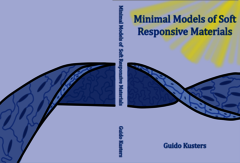Home Stretch | Modeling smart polymer materials
We’re using more and more materials that can adapt their form and function to external influences. Examples include polymers ‘that can do a party trick’. TU/e researcher Guido Kusters developed a mathematical model to make the development of a wide range of smart polymers – from fertilizer granules to miniature brains – more efficient. On Wednesday, May 29, he will defend his dissertation at the Department of Applied Physics and Science Education.
“It’s very likely you’ve already used one or more smart polymers today,” Guido Kusters chuckles enthusiastically, while he briefly touches his hand to his hair. “Like hair gel. That’s soft and malleable when you squeeze it out of the tube, but once it’s in your hair it gets hard so your haircut will remain firmly in place for the rest of the day. These materials are fundamentally soft, which is familiar from things like elastic bands, toothpaste, and any plastic packaging.” Kusters explains soft materials often have an unambiguous function. Plastic packaging, for example, separates the product from its surroundings. But it’s exactly the ease with which these materials can change shape that makes them very suitable for more complex functions in which they, for instance, need to adapt to changes in the environment. Then these materials are called soft responsive materials, says Kusters, and this is what he spent the past four years extensively researching.
Accessible method
Instead of spending hours in the lab, Kusters mainly worked on his laptop. He had a clear mission: he wanted to make the development of smart polymers more efficient using mathematical models. But doesn’t carrying out experiments teach us more? “If it were that easy doing it in a lab, we would,” Kusters emphasizes. “We’re often dealing with very precious materials and lengthy tests. You can’t try something out real quick. Especially when it comes to the optimalization of smart polymers, a calculation model will provide a more rapid indication of the way in which a material can be improved.”
He's definitely not the first to try and fit smart polymers into a model, says Kusters. And yet, his approach is unique, partly because his project is part of a large research consortium – Soft Advanced Materials. This involves multiple universities and research institutes working together, also with several industrial partners. “In earlier models, much more complex mechanisms were used, in a numerical way. That makes it very precise, but does require having a new complicated calculation carried out every time. Our new modeling method is much more accessible, as well as generically applicable. Which means it’s also easier to use in industry.”
Fertilizer granule
Kusters reaches for a little bag that’s lying on his desk, right next to his voluminous dissertation. “It’s one thing to make a model, but I also wanted to show that this model can be used for a great many smart polymers. From relatively simple polymer materials to more biological structures. I really researched a wide spectrum.” Kusters has opened the bag and takes out a few small granules. “Collaboration partner Corbion produces this urea granules, which are used in largescale agriculture. Normally, nutrients are released at the same time, but a gradual release would be much more desirable for plants and the environment. This can be achieved by coating the granules in a smart polymer.” The idea sounds simple, he says. “In a damp environment, the polymer layer will expand, making it porous. This allows the nutrients to dissolve into the water and be released. But the big challenge is to adapt the release profile of those polymer layers to the needs of the crops. And for this, we need to have a better understanding of the behavior of the polymer coating.”
Kusters’ model provided the required insights. “A fertilizer granule has to keep releasing nutrients for the entire plant cycle, which is six months at the very least. This means practical experiments are very time-consuming. We’ve analyzed which mechanisms are important for the release. The thickness of the coating, how the water flows through the passages, how crystalline the polymer we’re using is. My model allows you to modify the polymer coating and immediately see how the release will change.”
Curvy brains
Kusters put lots more in his model than just the urea granule. “I got inspired by the smart polymers that are being developed in the CEC research group Stimuli-responsive Functional Materials and Devices, such as the vibrating coating that can independently clean solar cells – or possibly even a Mars rover. What mechanism is behind this exactly? And how can we pre-program certain movements?” He spent four years at Harvard to contribute to the creation of a new material, based on biological tissues. Or the miniature brains, a project that he first came into contact with through the connections he established during his master’s internship at the University of Oxford. “The edges of an artificial mini brain on a chip get more wrinkly as time passes. Those wrinkles are crucial to the proper functioning of our curvy brains. A genetic disorder – lissencephaly, which literally means ‘smooth brains’, ed. – can reduce the wrinkling, which may lead to mental impairments. We would like to use our model to gain an insight into the wrinkling of the brain, possibly even use it to diagnose these kinds of impairments at an early stage.” However, he emphasizes, “I’m talking way into the future.”
That his dissertation describes an ostensibly wide range of applications “is definitely for good reason,” Kusters says. “We demonstrated that you can use a relatively generic approach to describe a great variety of soft responsive materials. And, at least as importantly, that you can subsequently draw useful conclusions from this. So for anyone wondering why we model things, that is the power of our model.”
PhD in the Picture
What is that on the cover of your dissertation?
“My PhD project in a nutshell. A soft responsive material, in this case performing a party trick when hit by light. The material is composed of three different structures, just like my dissertation. From polymer chains, to polymer chains with a complex internal structure, to biological tissue.”
You’re at a birthday party. How do you explain your research in one sentence?
“I make models for materials that can easily change shape and, at the same time, adapt to their surroundings in a smart way; my model can help develop even cooler functions.”
How do you blow off steam outside of your research?
“I do a lot of swimming, from laps in the SSC pool over lunch to – preferably – as part of a team. I played competitive water polo for years, now it’s become more recreational. Nothing makes me happier than lying in the water and throwing a ball around. All of the pushing and shoving involved in the game is another matter, given my physique. I prefer to let my swimming do the talking.”
What tip would you have liked to receive as a beginning PhD candidate?
“A PhD project is what you make of it. At the start, think about where you want to put the bar for yourself and try to take full advantage of any opportunities you get.”
What is your next step?
“I’m on the fence. I think academic work is very interesting, but it does involve more things that have a major impact on your personal life. Frequent relocations because of the virtually obligatory postdocs abroad, for one thing. And you can also do in-depth research at a company’s R&D department. It’s hard to weigh everything up against each other.”



Discussion